Energica Eva Ribelle (RS) 2021 electric motorcycle first impressions review
Visordown head to the Energica Eva Ribelle (RS) UK press launch at Gridserve, the UK’s first electric forecourt. How bonkers can an electric motorcycle get?
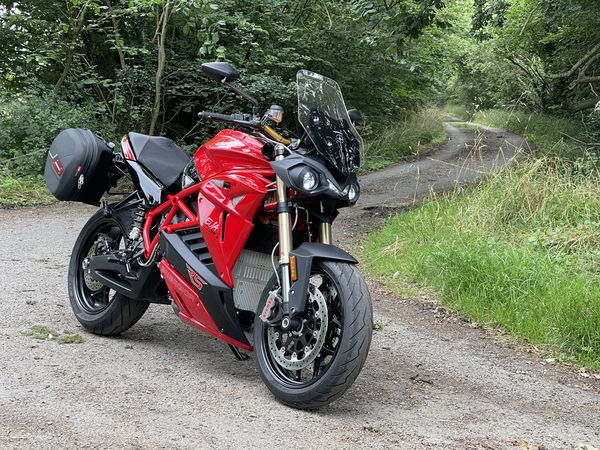
Many will hear ‘electric motorcycle’ and instantly put it into a box of ‘no soul, no character and no fun’ perhaps with the saving grace of that unbelievable torque on hand. I think the Eva Ribelle RS is the perfect example of changing that stereotype somewhat. We head out to the UK’s first electric forecourt, Gridserve, to sample the 2021 electric motorcycle at the Energica UK press launch.
Going into this my expectations were high - always a dangerous prospect for any review. I’d been told that my arms will be ripped out, it was portrayed as an electric speed demon that will not want to be tamed, and upon getting on the bike it was all of that - but still accessible.
It’s the most fun I’ve had on two wheels for quite some time. Quite simply ludicrous, and despite having only a sub-hour slot to experience the Eva Ribelle RS, it was enough time to figure out what makes this thing tick. Or buzz, as the case may be.
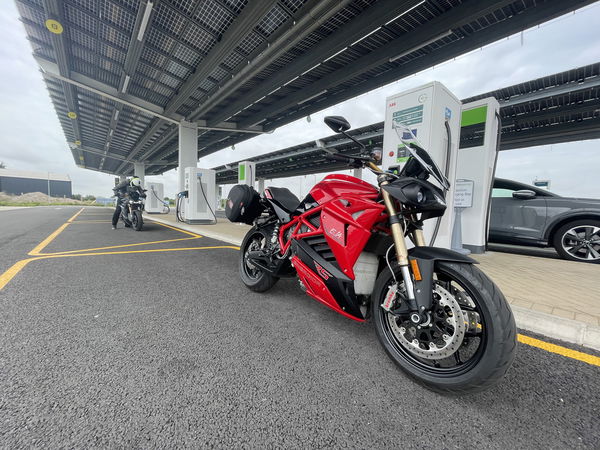
Energica has set the benchmark for electric motorcycles with the Eva Ribelle, but there’s a little bit of work to do before it’s ready for the general public. But hang on, let’s go through why I think that before we get to the verdict.
Electric engine spec
First things first, the motor on the Eva Ribelle is the new liquid-cooled EMCE unit shared across the three Energica machines (with the Ego & Eva EsseEsse9). A brand new Hybrid Synchronous Motor developed in partnership with Mavel, the 3-phase 300 V 12,000 rpm with Adaptive Control Inverter is 10kg lighter, smaller in size with greater thermal efficiency, yet provides more power and a touch more range with greater service intervals.
For those of us without physics degrees, this motor is an absolute unit. With peak power at 126 kW / 169 bhp on tap, and a frankly outrageous 215 Nm of torque (159 lb-ft) at the twist of the throttle, the high tech oil-cooled motor with permanent magnets is a serious bit of kit, and the best on the market.
0-60 is in 2.6 seconds, and (allegedly) speeds exceeding 100 mph are displayed on the dash within seconds - with a speed limited to 125mph for battery longevity and range reasoning. I was also told that a completely stock Ribelle was hooning around on track with BSB spec bikes, able to keep up (if not better) the other bikes there.
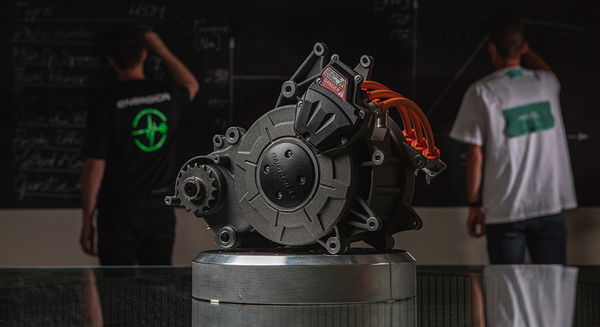
Energica Eva Ribelle RS price, availability & RS differences
I was riding the RS model, fitted confidently with touring panniers and in a stunning ‘Corsa Red’ colourway. The main difference for the RS is the removal of a tooth on the front sprocket, a Regina 15/44 525 O-Ring Chain being used with a new mapping and final drive, go-fast RS stickers & free rear-stand and indoor cover thrown in. Net result is a two-tenths quicker 0-60 time quoted above.
Price for the Eva Ribelle RS starts at £26,440, the standard £25,190 - a hefty price tag, but it’s a hefty bike in the upper echelons of the electric world, if not the very top. You can find them at a growing number of electric dealers in the UK, including English Electric Motor Co (just up the road from me!).
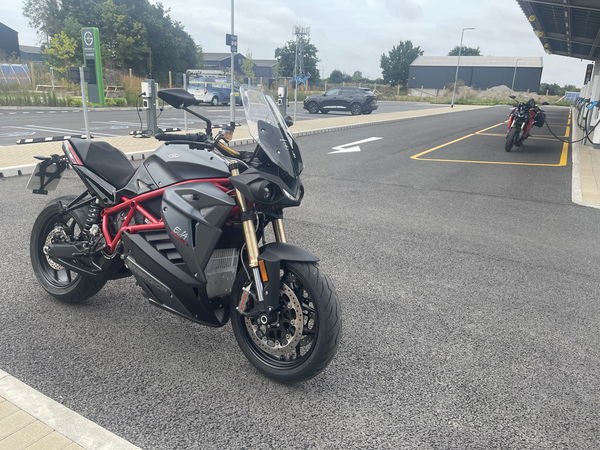
Electric detractions
Let’s address the ever-present electric detractions then: range, battery and charging times - and I’ve got a thought-provoking comparison for you.
Battery is a lithium polymer max 21.5 kWh with nominal 18.9 kWh, good for 1200 cycles with a 3-year 31,000 mile warranty (2 on the bike). Range is given as an optimistic 261 miles in the city, 123 miles highway. Setting off at 96%, my real-world riding returned an estimated range of 64 miles at 89% battery after a stint of ‘spirited riding’, then returned to base with 81% and 79 miles range. So it’s a varying number reflective of your riding, and I’d guess a 120+ mile range with a mix of riding, but I was only on the bike for under an hour.
The only bike with a built-in DC fast charger, recharging the battery can be done with a three-pin plug slow-charge, or 10-80% in around half an hour connected to 35kW DC charger (like at GridServe) costing about £2.60 per charge. The tank logo glows as it charges, reflecting the charge level. A nice playful touch, indicative of the electronic gadgetry within.

The battery is no issue if you can plan for charging stops or just ride the local jaunts, but do biker destinations need to start adding some chargers to ease electric adoption? Plug in your bike whilst you chat with your buds at Loomies, for example?
Consider this, too. An MT-10 is well regarded as a proper naked machine that contends this Eva Ribelle, but that has a thirsty appetite for fuel that can be depleted in around 140 miles. Sure it can be filled in under a minute, but it makes you think!
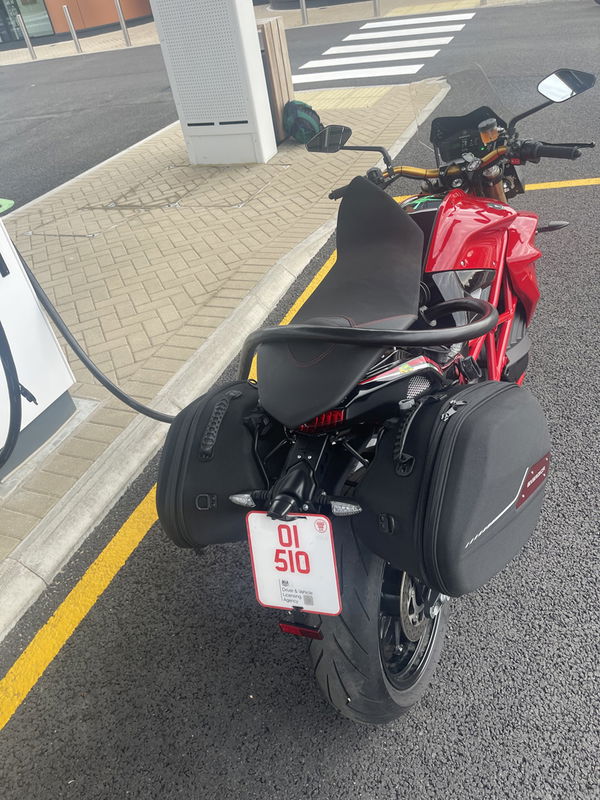
Riding opinion
Despite weighing a hefty 260kg, the weight is balanced well and down low (somehow, it all looks up high) allowing for some really satisfying lean-action that almost feels like it’s on rails when riding.
Straight-cut gears give the bike an oddly satisfying wail as you hurl down the road, and it’s too easy to chase that high-pitched wail into triple digits before you press down on the rear brake lever and feel ABS feedback with weight flying forwards - ‘why’s that coming in,’ I thought, ‘Oh I’m going quite fast’.
Once I was getting acclimatised with the power on offer, opening the throttle (even at 60) would hunker down on the rear, and the front wheel would begin to lift. A regular occurrence, but on a restricted private land only, officer.

Saying that, the throttle response is so instant you have to be incredibly disciplined when cornering - power delivery is effortless and direct on sports mode, and you could get into serious trouble if you’re not wise to it.
There are a few rider modes to play about with, and the intuitive switchgear works exactly as you’d expect once you suss it out. Engine braking at the full level really halts progress nicely, and sport mode gives a tremendous roll-on response. Change these about and you could have a twist and go city-slicker easily.
Worth mentioning the parking mode with low speed forward and rear movement too, handy for low-speed manoeuvring considering the weight.
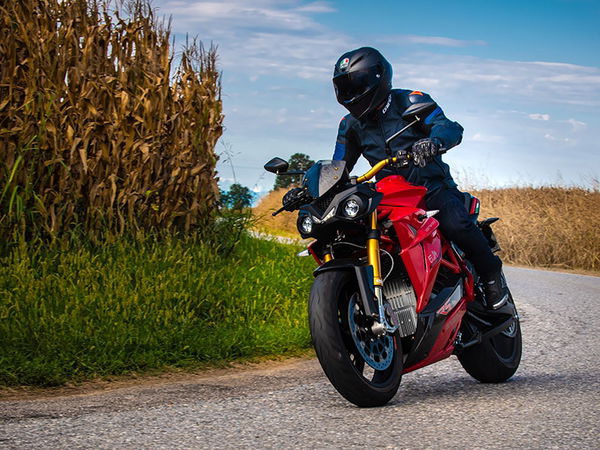
Spec and equipment
Where the Energica range exceeds in the growing competitive electric range is the spec. If you go to Energica with a fist full of cash, you can come away with anything you like - MotoE level machines, even.
Standard spec suspension is Marzocchi 43mm USD forks with adjustable rebound & compression damping and spring preload, rear Bitubo mono-shock with rebound and preload adjust. Optional extras include Ohlins if you prefer.
With the steel tubular trellis frame, the ride is responsive and firm, and 790 mm saddle is accessible and comfortable with grippy material to keep you in place. Wind screen is superb, too, and you can tuck in with little to no buffeting at speed.
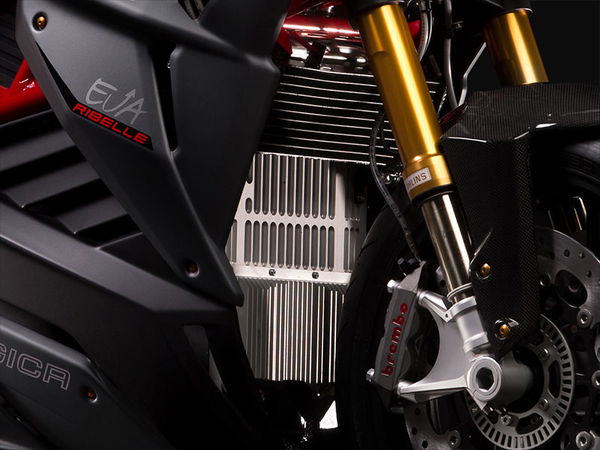
Brakes are mounted to 17” cast aluminium wheels running Pirelli Diablo Rosso III hoops, twin 330mm Brembo discs up front with 4 piston caliper, and 240mm single rear disc with 2 piston caliper & Bosch ABS. Combined with the regenerative engine braking, and its tremendous stuff, simply.
What do we like & dislike?
We love the power. The gadgety and spec is second-to-none on electric, and the riding experience is indicative of a changing tide when it comes to electric vehicles. It’s just pure riding pleasure.
We don’t like the price tag, it’s understandably high as a super-deluxe model, but if this could be brought down I think the average rider would be seriously tempted - and it is top-spec hand-built Italian quality. It almost feels like a gimmick to mark it down on range & battery considering it’s literally as good as it gets, for now. It does feel like a bit of a big toy, but that was dispelled once I got to grips with it - and the fella from Not Your Average turned up on his after 200 odd miles that morning.
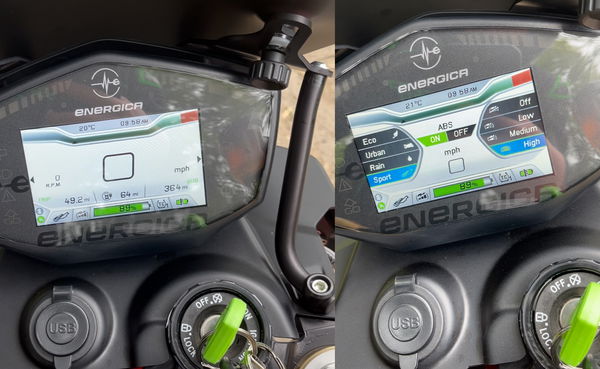
Verdict
The Energica range is a fantastic insight into the future and a looking glass into what is possible with this alternative form of mobility. Price and battery limitations do make it restrictive to be an early adopter, but as the electric network expands and purchase prices (hopefully) begin to fall, adoption will be much easier for riders outside of cities with excellent charging networks.
Can charging exceed past the 35 kW speeds? Short of shocking your battery with a lightning bolt, I’m not sure hazmat-suit-refilling is possible without getting dangerous. Happy to be wrong.
It’s well worth a test for anyone who owns a litre sports bike and wants to see what the fuss is about, I think most will happily side-step to this if the price is right - just factor in the charging and you’ll be grand. Give Alec at English Electric Motor Co a buzz for a test ride and he’ll happily arrange something, I’m sure.
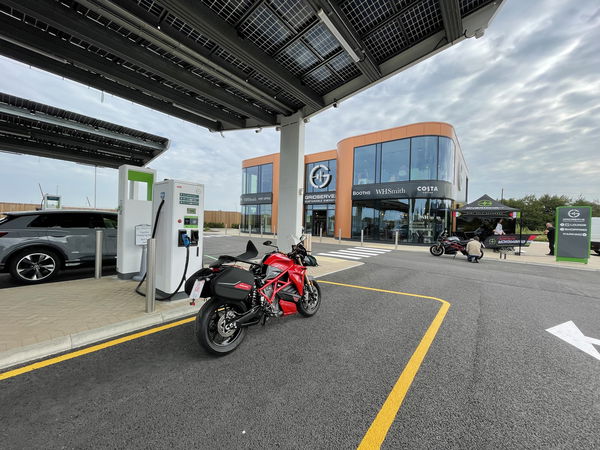
As I said at the start, the Energica range is now the benchmark I’ll be comparing big electric bikes to in future, even after a brief first impressions ride. Sure, there’s no combustion engine, but it still has character - it’s different but feels familiar. Step across from a big bike and it won’t disappoint.
If this is the electric future of motorcycling, I’m well on board. Few crinkles to iron, but it’s looking promising!











